Gallery
These are a few instruments which are in my personal collection or are no longer for sale. They are in date order and illustrate how the mountain dulcimer has developed over the last 50 years. The notes also provide biographical information about some key makers and demonstrate their very different design approaches. See also the section on Dulcimer Ancestors in Resources, which provides a short history of the dulcimer’s development.
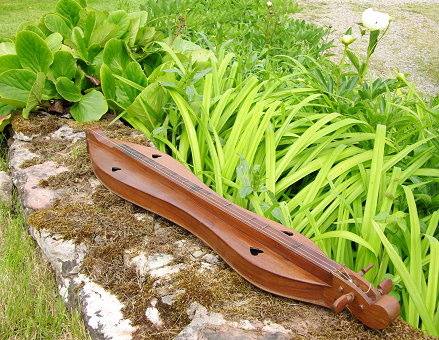
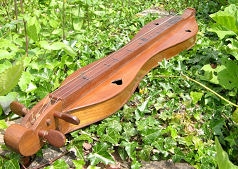

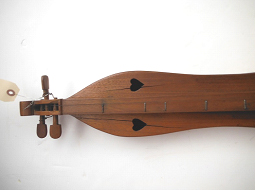
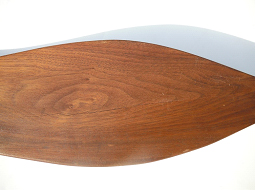
1957 – Amburgey 3 String Hourglass – NFS
Handwritten label inside says “#356/ Jethro Amburgey/ Hindman, Ky/ Sept. 9, 1957”.
Ralph Lee Smith in his seminal work “Appalachian Dulcimer Traditions” recounts that Jethro, born in 1895, began his education in an old log schoolhouse near his home. At the age of 11, his parents agreed to him attending the larger Hindman Settlement School in Kentucky, ten miles from the family home, providing he would “work his way”. He left the school to enlist in 1918 and saw action at Marne; returned safely to Hindman and graduated in 1920; remained there as workshop teacher and basketball coach until the early 30s; then enrolled at Morehead University and graduated with a bachelor’s degree in 1935. He subsequently became Knott County’s superintendant of schools and then taught for a further 20 odd years before retiring. He died in 1971.
His main claim to fame, however, is as a link between the early classic dulcimer maker “Uncle” Ed Thomas and the makers of the folk revival in the early 60s. Thomas supposedly made frequent visits to the Hindman workshop and Amburgey’s interest was piqued by the instruments he built and sold in the Hindman store.
He recalled seeing Thomas walking past the school workshop one day with a half-dozen or so dulcimers and going into a meeting of the settlement women. A while later, Thomas returned without a single instrument; he had sold them all. Amburgey figured that if people wanted dulcimers so much, he too should learn how to make them. When he asked for patterns, however, Thomas said that he would only provide them if Amburgey paid him more than he would normally receive for a finished instrument. Amburgey duly obliged and the dulcimers that he started building, as a result, were closely modelled on the Thomas original – a narrow, shallow hourglass with fiddle sides and staple frets under the melody string only.
The earliest Amburgeys date from the 1920s. By the early 60s, he had made nearly 500 dulcimers (charging $35 at the time). With demand accelerating, by his death in 1971 he had completed over 1300. Jean Ritchie used an Amburgey when she first went to New York in 1948 and caught the imagination of the nascent folk scene in the 50s and early 60s. In many ways, therefore, Amburgey established the norms for the dulcimer’s shape and sound in the revival era.
This dulcimer is all walnut, with a solid, quite thick, top and a single piece back. The back is secured at the headstock end by 4 tacks and at the tail by 5. The top has four heart soundholes pointing to the tail. Within the body, a square section soundpost links back and top, located just in front of the strum hollow.
The single piece solid fingerboard has a scribed mark ⅛” from each edge on top and side. There are 17 simple staple frets, set under the melody and middle strings only – some noticeably crooked. No 6½ fret. It has three hand cut walnut pegs in a simple, stubby scroll headstock; separate walnut bridge and endblock; single dowel-shaped string anchor.
This particular instrument was in a poor state when purchased. It had large cracks in the solid wood top, running from three of the soundholes, and two long cracks in the back. All appear to be caused by shrinkage rather than impact damage. The distinguished dulcimer historian Ralph Lee Smith mentions this as a problem in his book “Appalachian Dulcimer Traditions” and said that Amburgey began to use thinner, more stable laminates from the 1940s onwards.
A picture of an Amburgey from 1958 also appears to show repaired cracks in a solid wood back, so perhaps the transition was later than Smith suggests. The top pictures show it after repair by the Bristol luthier, Tom Waghorn.
Overall length 32½”, upper bout 4½”, lower bout 5¾”, depth 1⅝”, FBW 1⅛”, VSL 28″ (medium/long scale), weight 1lb 7oz (661g). No 6½ fret.
Despite the ravages of time and years of neglect, the Amburgey played well straight from the repair shop: soft, sweet, without great sustain but clear and responsive. It has a relatively low action and the intonation (tuning up and across the fingerboard) is surprisingly good for such a comparatively early instrument.

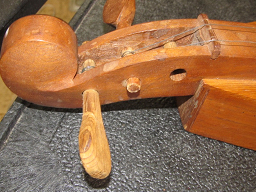
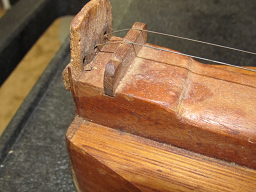
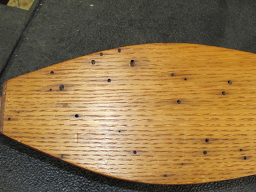
Aug 1964 – Presnell 3 String Hourglass – NFS
Printed label inside nearside LB soundhole reads: “Hand made by Mr and Mrs Edd Presnell/and Henry Cotter [or Cutter, handwritten].
/Woodcarving and Dulcimers/Banner Elk, North Carolina/Aug. 3 1964 [handwritten]/No. 336 [handwritten]” with the stamp of the Southern Highland Handicraft Guild.
Edward Lee Presnell (1916 -1994) took up dulcimer making in 1935 or 1936, having seen one played by his fiancé Nettie Hicks. Presnell was a farmer, mail carrier (?) and, later, full time woodcarver and dulcimer maker. He cut a distinctive figure in the craft fairs he and his wife attended, with his long beard and outcrop of bushy hair. His wife, from the musical Hicks family (who also built dulcimers), was a talented player who demonstrated Edd’s instruments. Edd and his wife were longtime members of the Southern Highland Handicraft Guild and in one application for membership renewal he describes his craft work being at the outset “a rainy day job in connection with farming”. Elsewhere, he credits his wife’s family with sparking his interest in making things.
This dulcimer is made almost entirely from wormy chestnut, bookmatched on the top but not the back. Presnell’s signature design of a continuous, integral fingerboard, pegbox and scroll is made from walnut (?). The fingerboard is hollow, with no position markers. The elegant, tapered pegbox is hollowed out by hand, leaving a solid base. There is only one original hand-carved peg left, apparently made of walnut (?). Nut and bridge appear to be walnut and are set to a very high action. Heart shaped soundholes in upper and lower bout, tails pointing to the head end. Tailpiece is a thin vertical piece of wood, extending higher than the bridge, rather like Ledford designs, with the strings running over a strainer/reinforcing bar below the string holes. The string anchors comprise a single small screw head. Unlike later instruments, Presnell has not scribed his name, instrument number and year on the back of the pegbox. Overall length 34½”, upper bout 4⅝”, lower bout 6⅛”, depth 1⅞”, FBW 1¼”, VSL 29″ (long scale). Original 6½ fret.
This particular instrument has been damp at some stage and sustained damage to the thin and rather vulnerable tailstock. With replacement pegs and careful restoration of the tailstock and overall finish, however, it has turned into a very handsome dulcimer, glowing a deep golden yellow.
It is best played when tuned to Ccc with the unfretted melody string significantly flat. Played vigorously with a noter – which pulls it back into pitch – it can play in several modes and make a remarkable noise – at once loud, sweet and nasal.
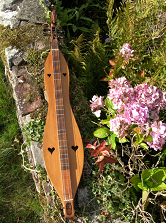
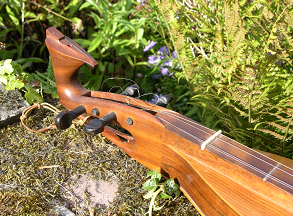
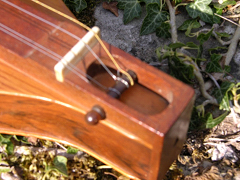
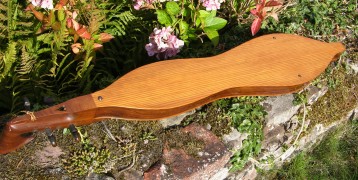
1968 – “Fairport” Frank Bond 4 String Hourglass – NFS
Created by the once fashionable English maker Frank Bond – a favourite of Roger Nicholson – and purchased for the Fairport household by Fairport Convention’s first female singer, Judy Dyble.
Chosen (and presumably played by) Richard Thompson (her then boyfriend) and/or “Tyger” Hutchings. Not used in any extant Fairport recordings, as far as we know.
Elegant headstock like the prow of a boat, with a heart cutout on the underside. Slim, elegant outline with softwood (spruce) top AND back, brazilian rosewood sides.
Heart-shaped soundholes (pointing to tail). Mahogany neck with rosewood (?) overlay and nickel frets.
Other unusual features: huge distance between pegbox and nut, suggesting the scale length was reduced during construction (picture 2); and the string anchor, basically a removable pin, as seen in a Finnish kantele (picture 3).
Light construction and softwood back make this quite loud, with a bright, sweet tone. An attractive and historic instrument.
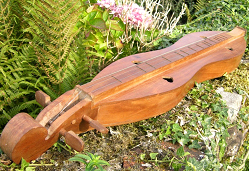
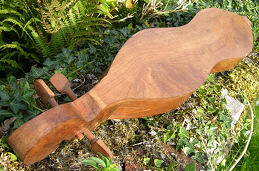
July (?) 1969 – Jess Patterson 3 String 3 Course Hourglass – NFS
Printed label inside nearside LB soundhole reads: “Jess Patterson/Pine Mtn., Kentucky/ Date: 7/6 69 [handwritten]”.
As a young man, Jess Patterson (1909 – 1983) worked the coal in Harlan County to support his young family. Later, he got a job at the Pine Mountain Settlement School, driving the school bus. But because he lived three miles away and had to walk to work, he often used to stay on the campus until he had to drive the bus again in the afternoon. The Director, taking pity on him, asked him “why he didn’t go up in the school wood shop and make something”. Learning how to use lathes and woodworking tools, he soon became school handyman, helping out also in the fields and hauling lumber.
It was there that a younger colleague in the woodshop showed Jess how to make a dulcimer – and he simultaneously discovered the musician within. By 1976, he had made over 500 dulcimers. Despite – or perhaps because of – his geographical isolation and the lack of local makers, he began to create unusual designs. He built big dulcimers like this one – much more N Carolina/Presnell than Kentucky/Amburgey; and dulcimers with scalloped or undercut fingerboards to minimise contact with the top and maximise sound pressure.
His construction techniques were very much in the tradition, nonetheless:
“I make my frets out of nails, hand carve the pegs, carve the head. The nails are eight gage about 1½” long…. You don’t know what is in the wood or tree until it’s cut up….Each [dulcimer] has a different sound. When I first started making them, I could hear a different sound in each of them. I don’t know whether it’s the time I put in it or the wood.”
This dulcimer is almost entirely made from cherry with a thick (5mm/3/16th) single piece top and back; heart soundholes with tails pointing toward the tail. The interesting hand hollowed pegbox and simple scroll is tapered towards the base, with neat, hand cut pegs. The fingerboard is solid, with no position markers; thick wooden nut and bridge; handmade (irregular length) staple frets under the melody and middle strings only. Slightly uneven string spacing at nut, resolving itself by bridge end. Single dowel string anchor.
Overall length 34¾”, upper bout 5⅝”, lower bout 6½”, depth 2⅛”, FBW 1⅜”, VSL 28″ (med/long scale). No 6½ fret.
This particular instrument has been damp at some stage, but the finish has survived well. Cleaned, oiled and lightly polished, it shines out again as it did originally. This is a BIG instrument – both in dimensions and weight – yet it has a mild, sweet tone. Remarkably good intonation for such an old instrument, only the odd fret being slightly out.
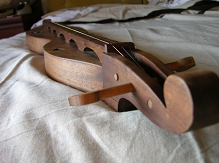
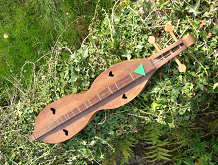
1974 – Gene Wiggins 3 String Hourglass – NFS
Handmade by Gene Wiggins, N Georgia. Dr Wiggins was an ethno-musicologist who built mountain and hammered dulcimers in small quantities.
The whole instrument (apart from the tuning pegs) appears to be of walnut and has an elegant shape with some unusually advanced construction features. The narrow fingerboard is scalloped (arched) and the tailpiece cantilevered to allow maximum movement of the soundboard. Strutting is light and two soundposts run diagonally from the treble side to the bass in the lower bout. The sides and top are thin to maximise sound pressure.
Very loud with short attack, a clear treble and a rumbling bass. A historic and unusual, but extremely playable, mountain dulcimer.

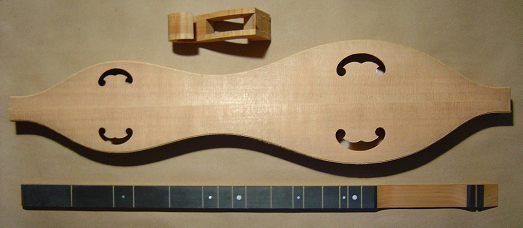
Mid 70s – Magic Mountain Model 5400 “Kit” 4 String – NFS
An exciting project – which has not progressed too far at the moment because of the pressure of set-up work etc in the workshop.
This “kit” was advertised in Everything Dulcimer in Autumn 2012 by Jim Shellnutt who designed and built high-end Magic Mountain dulcimers in San Rafael, California during the 1970s. This was the last set of parts from the original workshop, still unassembled after nearly 40 years and left over when the business was sold and he turned to antique restoration.
Made of beautiful curly maple and sitka spruce, this is a work-in-progress instrument, unfinished, in three parts – a completely assembled body, a completely assembled neck, and a completely assembled “elephant trunk” scroll headstock. It comes straight out of the Magic Mountain dulcimer production of the mid-1970’s. 32″ long x 7 ¾” wide x 2″ deep, 4 “C” shaped sound holes, top edges routed for 1/16″ violin purfling and 1/16″ edge binding, back edges routed for 1/16″ edge binding, highly figured curly Broadleaf maple back and sides (book matched), extremely tight-grained book matched Sitka spruce top. The figure in the maple runs the entire length of the sides and back (not just a few curls on one end); it is exceptional. This instrument body was designed and built for high-tension strings. It has full interior bracing for the Magic Mountain “box beam” construction.
Neck – American Cherry with black fiber fretboard, fretted, sanded and ready to use. Mother-of-pearl position dots (6 total), 32″L x 1 ½”W x ⅝”D, 30″ scale length, diatonic with “extra” fret. The first picture is of a contemporary 5400 from Jim’s personal collection, the second the fully assembled body (awaiting suitable binding), fully fretted fingerboard and headstock from the “kit”.
This shows clearly the level of sophistication in dulcimer design achieved on the West Coast of the US, with its history of high end guitar making. See also Dulcimer Works, Capritaurus and Folk Roots dulcimers.
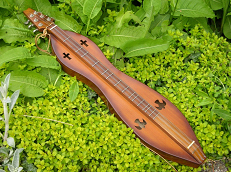
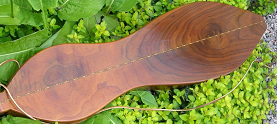
1977 – Bill Wasel 6 String Hourglass – NFS
Another very sophisticated dulcimer, for its time, handcrafted by Bill Wasel (1938 – 2007), St Petersburg, Florida.
Bill was an established 12 string guitarist and instrument repairman who opened a store called The First National Guitar Workshop in 1975 and immediately started building dulcimers – his then wife’s favourite instrument. His aim was ambitious: “The dulcimer was a parlor instrument, just for singing by yourself. People tried making them huge for more volume, but I didn’t think that was necessary. So I made some modifications of my own [including a hollow fingerboard, guitar-type bracing and guitar tuners]. My dulcimers are unique. They follow the traditional design but are set up as a contemporary playable instrument so that they can play with other instruments and be heard.”
This is a well-built, almost sunburst-coloured shallow 6 string with spruce top, decorated with dove and cross soundholes. Sides, fretboard and back are walnut, the back in particular being beautifully figured and bookmatched with a central line of purfling. It has (ahead of its time) a neat guitar-style flat headstock and 6 high quality enclosed Grover machine heads; thick bone nut and bridge; and a fret between tailpiece and bridge to give the right break angle on the strings. The bass course is strung as an octave pair, i.e. with low D and high D strings like a mandolin or 12 string guitar.
Overall length 35”, upper bout 6¼”, lower bout 7½”, height 1¾”, VSL 26″ (short scale). No 6½ fret.
This is very easy to play with a buttery action and clear note articulation – nothing like as jangly as 6 strings usually are. It has a well-balanced sound with a clear treble – perhaps more guitar than dulcimer? Basically, it sounds as distinctive as it looks!
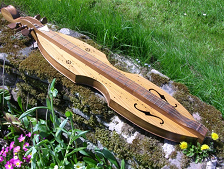
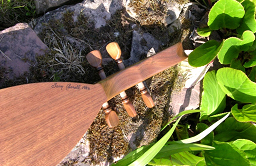
November 1982 – Sam Carrell 5 String, 4 Course – NFS
Wormy chestnut top/walnut back, fiddle-sided dulcimer by Sam Carrell, Townsend, Tennessee, marked “Handmade for Bettye McKenzie”. Bill Davis popularised this body style, now kept alive by the well-known luthier Mike Clemmer from Townsend, Tennessee.
Sam is now semi-retired and living in Florida. He talks about his dulcimer apprenticeship as follows:
“I met a dulcimer maker, Bill Davis—long since dead, in Gatlinberg, Tenn., after I moved there from my home in Florida , A VERY LONG STORY, & he asked me to work for him in his shop in East G[atlin]berg. I started with him in March of 1974 & quit in Sept of the same year. Let’s just say we had irreversible differences! I opened my own business, across the mountains, 25 miles away [Townsend, gateway to the Great Smokey Mts], in 1975. I closed the business & my wife & I moved back to Florida in 1984 to be with our very ill parents. Here’s how I learned to make his dulcimers—He took me into his shop, pointed out a dulcimer & said you’ll be making that. The ONLY thing I ever saw him do was turn the tuning pegs on an old Shopsmith wood lathe, fit them to the “peg head” of a dulcimer, fit a nut & bridge & then put on the strings & tune it up. I had to figure everything out myself by studying & measuring a dulcimer. His dulcimers had the extra fret & I eventually figured out what it was for. It made perfect sense to me at the time —“open tuning for the Mixolydian Mode”, easy for learners to use & understand. I made approximately 1300 to 1500 mountain dulcimers & at least 200 other instruments including Hammered dulcimers, Swedish Humles, Psaltrys, acoustic Guitars & many other instruments. I actually make a few instruments every year, some guitars, Mountain Dulcimers & the odd instrument upon request.”
This is a large, older-style dulcimer with five wooden tuning pegs, strung in four equidistant courses and designed for Mixolydian (1:5:8) tuning with a 6½ fret. It came with what were probably the original strings, sized 26w/22w/13/13 13 – appropriate for Sam’s favourite baritone A’/E/A/AA tuning. It has a wormy chestnut top, walnut sides and one piece walnut back, with fiddle edges. Carrell said of the top: “The Wormy Chestnut that I used was over 100 yrs old. It came out of the Joyce Kilmer National Forest near Franklin, North Carolina. It was/is the best sounding of all the woods I used for sounding boards”. The wide, hollow fingerboard (with central internal strut) and headstock are also walnut with five large (and very effective) turned walnut pegs. The top has two f-hole designs on the lower bout and round, flower-like designs formed from drill holes on the upper bout. The headstock has a wheat ear pattern on the top, repeated on the inside of the strum hollow. The strings are anchored on chrome screws. Wooden nut and floating bridge. It is signed and dated in black script (under the finish) on the upper bout, rather like Bill Davis’ instruments. This instrument came with original Jean Schilling spare dulcimer strings, two wooden noters and quill pick.
Overall length 39¼”, upper bout 7”, lower bout 7”, side depth 1¾”, FBW 1½”, VSL 28½ (medium/long scale), weight 2lbs 4oz (1010g). Original 6½ fret.
This is a lovely instrument, beautifully constructed from good quality materials (though with small bending flaws in three of the six side panels). Strung like the original and tuned as a baritone, has a big, mellow sound with an easy action, although the string action is noticeably low. I also have an identical 1977 Carrell with wormy chestnut top, which plays superbly in extended modern Mixolydian (D/A/d/dd) tuning.

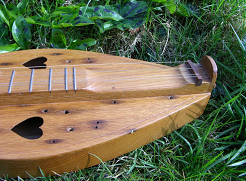
1983 – Clifford Glenn Hourglass 4 String – NFS
Dated January 10th 1983 and made by Clifford Glenn, Sugar Grove, N Carolina for the husband of Louisa M Douglass from Chapel Hill, NC. Clifford Glenn and his father Leonard kept the flame alive in the Appalachians between the traditional makers and the coming of the folk revival in the 60s and 70s. They represent a very important part of the dulcimer’s heritage. These are truly handmade, beautifully crafted instruments, as described in Ralph Lee Smith’s famous book “Appalachian Dulcimer Traditions”.
This instrument is made entirely of wormy chestnut, except for the nut, bridge and large, handcrafted tuning pegs which are made of walnut. A letter from Clifford to Mrs Douglass, which accompanies the instrument, runs in part as follows:
“The reason I made it from Chestnut is that not long ago I made another one just like it except that it was a three stringer, and it was one of the best singing ones I ever made. I have made but very few like this (all chestnut wood) and it has probably been 20 years since I made the last one. One of the reasons has been that we didn’t have the chestnut wood until comparatively recently…..I thought your husband might appreciate the fact that this wood is becoming increasingly rare, as it is not growing anymore, for the blight killed the native american chestnut these many years ago”.
Overall length 36½”, upper bout 5¾”, lower bout 6¾”, depth 1⅝”, VSL 28″ (medium/long scale). Unexpectedly, has a 6½ fret.
This is a delightful dulcimer. Long, light and elegant, with an inscribed purfling mark round the top, it has a beautiful, natural golden finish. Intonation is not perfect, but it has a gorgeous, big and attractively mellow voice, endorsing Clifford’s closing comments in his letter to the new owner: “Anyway the dulcimer did turn out to sound about as good as the three stringer, and I do hope your husband likes it.”
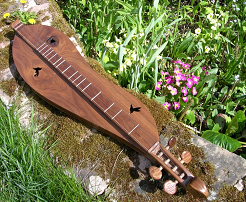
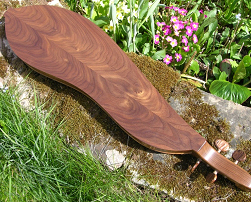
1992 – Warren May Hourdrop 4 String, 3 Course – £Sold
Handmade by Warren A. May, Berea, Kentucky, #6957. Warren is a cabinet maker and well known instrument builder, carrying on the tradition of Homer Ledford and other Kentucky makers. The construction and finish on this dulcimer are beautiful.
This is Warren’s distinctive “hourdrop” design, in which the treble side is an hourglass shape and the bass side a teardrop – aiming to maximise the treble response of the former and the bass of the latter. It is a traditional all walnut model with carved headstock, hand cut wooden tuning pegs, wood nut and (floating) bridge and no 6½ fret. The top has two beautifully cut hummingbird soundholes and another formed from a natural knot. Bookmatched walnut back with beautiful figure. Endblock takes ball end strings only. Overall length 34¾”, upper bout n/a, lower bout 8½” (at widest point), depth 1¾”, FBW 1½”, VSL 26⅜” (medium scale), weight 1lb 3oz (829g).
A lovely piece of craftsmanship and a real looker, but also practical and musical. Bright but woody tone, with responsiveness and some power, aided by light, hardwood construction.
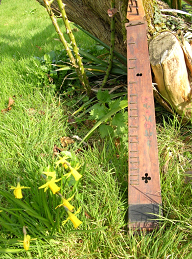

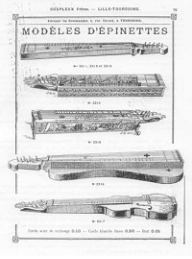
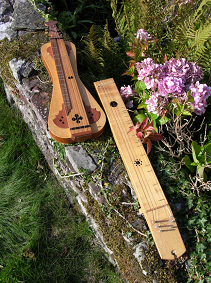
Various Epinettes Des Vosges – NFS
Some examples of instruments in the same fretted zither family as the mountain dulcimer, early examples of which have been found in the USA. Several experts have posited the theory that migrants from Europe introduced the concept of a small, portable instrument which could be easily fabricated from cheap, local materials.
No maker’s name, but several clues help identification and dating (c1900).
It is a Val d’Ajol-style instrument but its length, number of strings (3 melody, 4 drone), the 6½ fret and its decal or transfer flower decoration suggest an instrument from Flanders or Brabant in the North. A very similar dulcimer (top instrument above) appears in the catalogue of a large scale epinette maker from the turn of the century called Coupleux, based in Turcoing/Lille – right on the Belgian border in the North East of France.
The headstock appears to have been machine-shaped from a hard, white wood such as beech or maple. The sides are softwood, probably spruce or pine. The top and back may also be softwood or could be a soft hardwood, perhaps fruit wood (cherry/apple/pear)? Soundholes are simple shapes formed from holes – a quatrefoil towards the bass and a duofoil in the treble. The brass staple frets (running under the melody strings only) are arranged diatonically (but with a 6½ fret) and attached directly to the soundboard. The nut is brass and the bridge hardwood. Overall length 25¼ (64mm), width 3¼” (8mm) tapering to 2” (5mm), depth 1¼” (2mm), VSL 18¾ (47.5mm). Seven dulcimer/piano pin style tuning pegs.
Unfortunately, the body is significantly distorted and hence unlikely ever to be strung, but given the small volume of the body and very light construction, it is likely to have been typically light and trebly.
LH epinette was handcrafted by Michael W Fluegge, Osnabruck, Germany (10/2009). Small Val d’Ajol model of epinette with 2 melody strings (chanterelles) and 3 drones (bourdons). Has a shallow rectangular box structure superimposed on a larger, more curvaceous body. Body (sides, back, peghead) is made from German cherry. Fretboard and peghead overlay are rosewood. Reddish ornamental “leaves” on top are steamed pear. Nut and bridge are ebony. Soundboard is an unknown African softwood. 16 fret fingerboard has modern guitar-type frets arranged diatonically, like a dulcimer. Overall length 27”, upper bout 9”, lower bout 6⅛”, VSL 18½” or 47mm (very short scale!). 6½ fret. Very light construction gives a large and balanced sound which belies its small size – especially if played on a table top for added resonance.
RH epinette is a student model from the eminent Vosges luthier/player Christophe Toussaint. Simple, maple box body with 3 melody and 3 drone strings; staple-type frets. No 6½ fret. Endpins – placed on a printed stave – show the notes to which the strings should be tuned!
